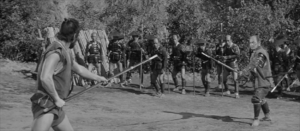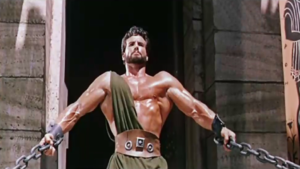Hidden Fortress
The Hidden Fortress
Rating: *****
Origin: Japan, 1958
Director: Akira Kurosawa
Source: Amazon streaming video

The sound bite on The Hidden Fortress is that it’s the Kurosawa film that inspired Star Wars, but if you go into it expecting to see some kind of samurai cognate to the Skywalker saga, you’re going to be disappointed, and worse, you may overlook the very real pleasures this film has to offer. Yes, Hidden Fortress did inspire some aspects of George Lucas’s approach to Star Wars, but just put that aside and let this movie win you over on its own terms.
This is the director working firmly within the tropes of the “Chambara,” or historical swordplay film, but he can’t resist subverting those tropes even as he displays his mastery of them. Kurosawa does this from the very beginning: a bombastic march plays over the opening credits, dissolving onto a shot of a country road. But instead of a masterless samurai striding into a new adventure, staggering down the road are a couple of losers, two would-be warriors fleeing the aftermath of a battle. These peasants, Matashichi (Kamatari Fujiwara) and Tahei (Minoru Chiaki), are clown characters, greedy but feckless cowards who bicker constantly. But this pair provides the picture’s point of view, and we watch the actions of the samurai-class characters, heroic and not-so-heroic, through the eyes of these ordinary folk.
The two losers, lamenting their fate, are on the run after the Akizuki clan was defeated and nearly destroyed by the Yamana. Though they’d intended to fight for the Yamana, the pair are soon swept up with the fugitive Akizuki and pressed into forced-labor gangs digging through the ruins of the losing clan’s castle, seeking its hoard of gold. The Yamana samurai treat the workers like animals, and they rise up (with no help from Matashichi and Tahei) in a brilliantly-depicted night revolt in the ruins. (This is Kurosawa’s first widescreen film, and he uses the format’s scope and depth-of-field to great effect.) The clowns take the opportunity to escape, and soon revert to the status of fugitives starving in the countryside. They try to return to their province of Hayakawa, but the Yamana are guarding the border, and they are foiled. Desperate, they make their way into the mountains, and make a campfire to cook some stolen rice. But in the firewood, hidden in a thick branch, they unexpectedly discover a slim gold bar stamped with the Akizuki crest. Have they discovered a clue to the lost Akizuki hoard?
Indeed they have, and more than that, they discover its guardian, the Akizuki general Rokurota Makabe (Toshiro Mifune), and the clan’s sole surviving leader, Princess Yuki (Misa Uehara), who’ve temporarily taken refuge in a mountaintop “hidden fortress.” Rokurota presses the clowns into service by exploiting their greed for the gold, but the Yamana are closing in, so the four, with the two samurai disguised as commoners, set out to try to get across the border to Hayakawa.
Now we are firmly in Chambara adventure territory, and Kurosawa alternates scenes of exciting samurai action with poignant interludes among the peasantry, where the disguised princess, who’s been raised in a castle, learns what life is like outside the samurai’s rigid duty-bound society. These scenes are wonderful, moving and sharply-drawn, plus we’re treated to the greatest samurai spear fight ever filmed, as Rokurota duels and defeats Hyoe Tadakoro (Susumu Fujita), a Yamana champion. Tension grows as the Yamana hunt the fugitives, and the movie picks up pace as it rushes toward its climax, which I won’t reveal, but it’s both exciting and satisfying. The film ends as it started, with the two peasants walking away from the deadly honor-driven world of Japan’s warrior class, headed home to their village at last.
